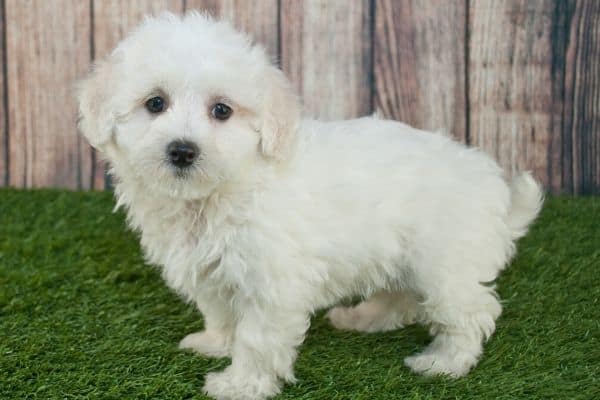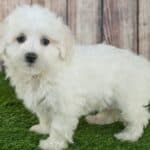Even those who aren’t particularly fond of small dogs often find themselves utterly smitten by a charming Maltipoo.
What’s not to love? Both the Maltese and Poodle are friendly, gentle, playful, low-shedding, and smart. Combine them together, and you have an ideal little companion dog.
How big do Maltipoos get? Maltipoos can weigh anywhere from 3 – 18 pounds and measure 6 – 14 inches tall, depending on the size of the parents. Although most will be 7 – 14 pounds and 8 – 12 inches tall at the shoulders.
Adult size depends heavily on whether a toy or miniature Poodle was used.
Like many crossbreeds, Maltipoos can vary in size considerably. Keep reading to find out why and see when you can expect them to reach full maturity.
How Big Will a Maltipoo Grow to Be?
While no one can predict exactly how big a Maltipoo will get, most will wind up at an adult weight between 7 – 14 pounds and will be approximately 8 – 12 inches tall at the withers (top of shoulders).
As is true of people, genetics play a large role in determining potential adult size.
Size of Parents
As you know, a Maltipoo is a combination of a Maltese and a Poodle, both of which are small dogs.
What you may not know is that while the Poodle parent is usually a toy variety, miniature Poodles have been, and are sometimes still, participants in the formation of this designer breed.
It stands to reason that the larger the parents are, the larger the puppies will tend to be, and indeed this is often the case.
A quick glance at the standard sizes of the breeds behind the adorable Maltipoo will give you a better understanding of why size can fluctuate in this designer breed.
Maltese
According to the American Kennel Club (AKC) breed standards, a Maltese is to weigh under 7 pounds and be between 7 -9 inches high.
There’s not much wiggle room here as the standards for this breed (which dates back to around 1500 B.C.) have been in place for many years and are quite well established.
Toy Poodle
The AKC stipulates that Toy Poodles weigh between 4 – 6 pounds and stand 10 inches or less at the shoulder.
Adult Toy Poodles whose weight is outside of this range are either overweight or are the product of poor breeding practices.
Miniature Poodle
Miniature Poodles meeting the breed standards will weigh 10 – 15 pounds and be less than 15 inches tall. Well-bred dogs shouldn’t deviate too much from this range.
You can see how using a Miniature Poodle in a Maltipoo breeding program would greatly affect the size of puppies.
Maltipoos with a Miniature Poodle in their bloodline may still exhibit a larger size several generations down the line thanks to the complex world of genetics.
[mv_video doNotAutoplayNorOptimizePlacement=”false” doNotOptimizePlacement=”false” jsonLd=”true” key=”yahuwlonb1dselzhwqio” ratio=”16:9″ thumbnail=”https://mediavine-res.cloudinary.com/v1607521240/z6c6mi29ecupjy8dg0dd.jpg” title=”Meet 6 Adorable Maltipoos” volume=”70″]
Generation
Puppies produced by breeding a purebred Maltese to a purebred Poodle are known as F1 generation.
These puppies may strongly resemble one parent but inherit the personality of the other.
In an F1 litter, not all puppies are guaranteed to look alike.
Sure, some may, but others may appear to be carbon copies of one parent and not look like a mixed breed at all.
When an F1 is bred back to a parent breed the resulting litter is termed F1B generation, and features and traits of the parent breed used are intensified.
The F2 generation comes from breeding two F1s together. If an F2 is bred back to a parent breed or if an F1B is bred to an F1, the pups would be considered F2B.
Breeding two F2 generation dogs will produce F3 puppies which could then be backcrossed to a parent breed to earn an F3B classification.
F3 generations and beyond are often simply referred to as multi-generational.
The more generations of Maltipoos a particular breeder has worked through, the more accurately he or she will be able to predict the puppies’ adult size.
However, it may take many, many generations of Maltipoos before their size becomes completely standardized and not prone to extremes, especially if a Miniature Poodle was ever part of the mix.
Tip: When your puppy is 4 months old, take his weight and multiply it by 2 to estimate what his adult weight will be.
Impacts More Than Just Size
Know that generation doesn’t only affect the size of the dog. It also has an impact on how much or how little the dog will shed and what type of coat he will have.
Our article “Do Maltipoos Shed?” explains this in greater detail and provides valuable information on what to expect as far as coat changes are concerned.
If you’re not familiar already with Maltipoo coat types and the amount of grooming they’ll require, check out our Maltipoo grooming guide.
In addition to dealing with tear stains and anal glands, it explains everything else too, including:
- Routine brushing – a slicker brush is a must-have.
- Bathing – this conditioner is the best.
- Ear cleaning – these drops make it fast and easy.
- Dental care – this dental hygiene set includes a toothbrush, finger brush, and dog-safe toothpaste.
When Do Maltipoos Reach Maturity?
There are three elements of maturity: physical, mental, and sexual, and they’ll each be reached at different ages.
A Maltipoo will only be considered completely mature when each of these aspects has been fully realized.
Physical Maturity
The growth of a Maltipoo’s skeletal system is completed by 10 -12 months of age, but many dogs may continue to gain fat and muscle until they reach 18 months old.
After that, they should stop growing.
Mental Maturity
Mental maturity occurs gradually as a Maltipoo slowly nears adulthood.
Usually, puppy-like behavior begins to fade just before the one year mark but may not permanently disappear for several more months.
Note: Undisciplined dogs may continue to engage in behaviors typically associated with puppyhood, like chewing remotes or having accidents, well into adulthood. This isn’t a sign of slow development but simply a lack of training on the owner’s part.
Sexual Maturity
Because small breeds tend to mature slightly faster than larger breeds, Maltipoos may show signs of sexual maturity as early as 4 months old.
By 6 months of age, both males and females are usually capable of reproducing.
Are There Different Size Classifications for Maltipoos?
When you begin looking at Maltese breeders, you’ll soon discover that some breeders market their Maltipoos as teacup, toy, or small, and the weight limits they use for classification can vary.
Though misleading and even underhanded, terms such as teacup are often tacked on to the description as a marketing ploy.
So, what is the true meaning of the terms, and do they apply to Maltipoos?
Teacup
This term typically refers to dogs weighing less than 4 pounds.
“Teacups” are usually produced by breeding very small dogs, often the runts of two litters, together and are frequently plagued by numerous health issues.
The American Kennel Club does not recognize the term “teacup” as a size classification.
Toy
Dogs weighing less than 10 pounds are classified as “toy” sized. Many Maltipoos fall under this classification, including those marketed as “teacups.”
Miniature
This term, which some breeders may call small and others may call medium (I know, very confusing!), is generally used for dogs weighing between 10 – 25 pounds.
Maltipoos on the heavier end of the scale would fit into this category.
Looking at both the sire and dam of the litter you’re interested in will give you a relative idea of your puppy’s adult size.
No matter what term the breeder chooses to use, you can rest assured that your new Maltipoo will be on the small side and will most likely be well under 20 pounds when full grown.
What and How Often Should I Feed a Growing Maltipoo?
Small breeds like the Maltipoo typically have a higher metabolic rate than larger breeds do.
This means that their little bodies require more calories per pound and will benefit from a diet specifically designed for their needs.
Feeding your pup a reputable, name-brand kibble created for small breed puppies will ensure that he receives the correct amount of critical nutrients every day.
Choose food that has a traditional meat, such as chicken or lamb, as the first ingredient. Avoid feeds that contain fillers or questionable ingredients such as synthetic preservatives.
Not sure what to look for when selecting a dog or puppy food? When your done here, be sure to read our guide to choosing the healthiest food option.
You’ll learn a ton about finding a truly high-quality dog food and how to decipher confusing labels.
Small breed puppy feeds like Purina Pro Plan Focus and Blue Buffalo Freedom are both very popular and are usually well tolerated by sensitive tummies.
Actively growing puppies should be fed three or four small meals throughout the day.
Follow your feed manufacturer’s guidelines for the recommended daily serving size and divide that amount equally into three or four portions.
A good routine to follow at each mealtime would be to take your Maltipoo for a walk or engage him in some puppy playtime, allow him to eat in peace, and then head directly outside for potty time.




